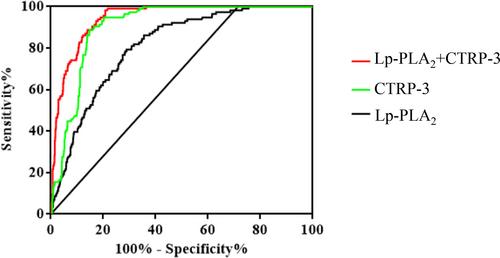The relationships between biological novel biomarkers Lp-PLA2 and CTRP-3 and CVD in patients with type 2 diabetes mellitus
Abstract
Background
Cardiovascular disease (CVD) is recognized as a primary and severe comorbidity in patients with type 2 diabetes mellitus (T2DM) and is also identified as a leading cause of mortality within this population. Consequently, the identification of novel biomarkers for the risk stratification and progression of CVD in individuals with T2DM is of critical importance.
Methods
This retrospective cohort study encompassed 979 patients diagnosed with T2DM, of whom 116 experienced CVD events during the follow-up period. Clinical assessments and comprehensive blood laboratory analyses were conducted. Age- and sex-adjusted Cox proportional hazard regression analysis was utilized to evaluate the association between lipoprotein-associated phospholipase A2 (Lp-PLA2), C1q/tumor necrosis factor-related protein 3 (CTRP-3), and the incidence of CVD in T2DM. The diagnostic performance of these biomarkers was assessed through receiver operating characteristic (ROC) curve analysis and the computation of the area under the curve (AUC).
Results
Over a median follow-up of 84 months (interquartile range: 42 [32–54] months), both novel inflammatory markers, Lp-PLA2 and CTRP-3, and traditional lipid indices, such as low-density lipoprotein cholesterol and apolipoprotein B, exhibited aberrant expression in the CVD-afflicted subset of the T2DM cohort. Age- and sex-adjusted Cox regression analysis delineated that Lp-PLA2 (hazard ratio [HR] = 1.007 [95% confidence interval {CI}: 1.005–1.009], p < 0.001) and CTRP-3 (HR = 0.943 [95% CI: 0.935–0.954], p < 0.001) were independently associated with the manifestation of CVD in T2DM. ROC curve analysis indicated a substantial predictive capacity for Lp-PLA2 (AUC = 0.81 [95% CI: 0.77–0.85], p < 0.001) and CTRP-3 (AUC = 0.91 [95% CI: 0.89–0.93], p < 0.001) in forecasting CVD occurrence in T2DM. The combined biomarker approach yielded an AUC of 0.94 (95% CI: 0.93–0.96), p < 0.001, indicating enhanced diagnostic accuracy.
Conclusions
The findings suggest that the biomarkers Lp-PLA2 and CTRP-3 are dysregulated in patients with T2DM who develop CVD and that each biomarker is independently associated with the occurrence of CVD. The combined assessment of Lp-PLA2 and CTRP-3 may significantly augment the diagnostic precision for CVD in the T2DM demographic.


 求助内容:
求助内容: 应助结果提醒方式:
应助结果提醒方式:


